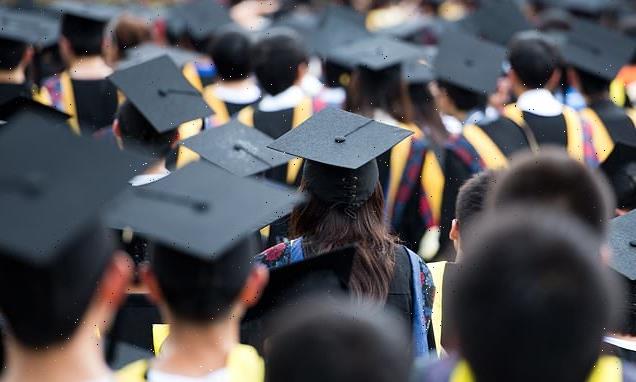Student loan interest rate to more than DOUBLE in England and Wales
Student loan interest rate to more than DOUBLE from 4.5% to 12% in England and Wales: Financial watchdog IFS slams ‘no good reason’ for ‘eye-watering’ hike facing graduates amid cost-of-living crisis
- Institute for Fiscal Studies said this year will be ‘rollercoaster ride’ for graduates
- Graduates earning £49,310 or more will see interest rates rise from 4.5% to 12%
- Interest rates for low earners are set to rise from 1.5% to 9%, the IFS also said
- The IFS calculated it by looking at current retail prices index (RPI) inflation rates
Graduates in England and Wales will be paying up to 12% interest on their student loan repayments later this year, according to the Institute for Fiscal Studies.
The financial watchdog said the rate will more than double from the current 4.5% as it said there was ‘no good reason’ for the ‘eye-watering’ hike amid the cost of living crisis.
The IFS predicted this year will be a ‘rollercoaster ride’ for graduates who took out their student loans since 2012.
The new rates would mean students are charged higher rates of interest on their loans than homeowners paying off mortgages.
The Institute for Fiscal Studies (IFS) has calculated that because of current retail prices index (RPI) inflation rates, the maximum interest rate on loans – paid by those earning £49,130 or more – will rise from current rates of 4.5% to 12% for half a year.
Interest rates for low earners are set to rise from 1.5% to 9%, the IFS said.
They added that this means a high-earning recent graduate with a typical loan balance of £50,000 would incur £3,000 in interest over six months, a higher amount than a graduate earning three times the median salary for recent graduates would usually pay.
The IFS said that the maximum student loan rate was then set to fall to around 7% in March 2023, fluctuating between 7% and 9% for a year and a half.
Graduates in England and Wales will be paying up to 12% interest on their student loan repayments later this year, according to the Institute for Fiscal Studies
‘In September 2024, it is then predicted to fall to around 0% before rising again to around 5% in March 2025,’ the IFS said.
‘These wild swings in interest rates will arise from the combination of high inflation and an interest rate cap that takes half a year to come into operation.’
The IFS said that without the rate cap, maximum rates would be 12% during the 2022/23 academic year, rising to around 13% in 2023/24.
They said that the ‘interest rate rollercoaster’ would cause problems, as the interest rate cap disadvantages students with falling debt balances.
It could also put students off going to university, or push graduates to pay off loans when this would have no financial benefit for them.
The ‘eye-watering’ rises are linked to the Retail Price Index and a rise in the cost of living.
Interest rates on student loans are usually charged between the RPI inflation rate and the RPI inflation rate plus 3%.
But there is a lag between the RPI inflation rate and student loan interest rates, which the IFS calculates means that current high inflation rates will mean high student loan interest rates for 2022/23.
‘This high reading implies an eye-watering increase in student loan interest rates to between 9% and 12%,’ the IFS said.
‘That is not only vastly more than average mortgage rates, but also more than many types of unsecured credit. Student loan borrowers might legitimately ask why the Government is charging them higher interest rates than private lenders are offering,’ they added.
Student loan interest rates are not supposed to rise above market interest rates, but lags between when the market interest rate is measured and the DfE taking action mean that between September 2022 and February 2023, students will pay uncapped rates.
The situation is likely to disadvantage higher-earning graduates. Borrowers whose debt is falling over time will be charged more than those whose debts are rising.
The IFS said this would lead to ‘unfortunate redistribution’ between graduates.
Ben Waltmann, senior research economist at the IFS, said: ‘Unless the Government changes the way student loan interest is determined, there will be wild swings in the interest rate over the next three years.’
‘The maximum rate will reach an eye-watering level of 12% between September 2022 and February 2023 and a low of around zero between September 2024 and March 2025.
‘There is no good economic reason for this. Interest rates on student loans should be low and stable, reflecting the Government’s own cost of borrowing.
‘The Government urgently needs to adjust the way the interest rate cap operates to avoid a significant spike in September.’
Source: Read Full Article




